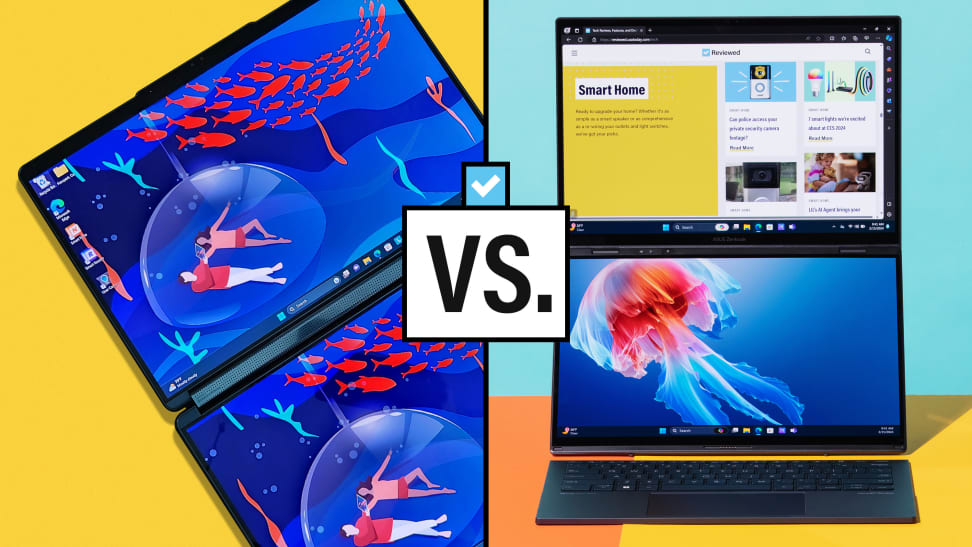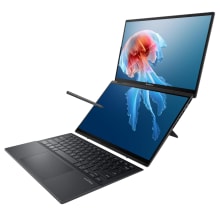Asus Zenbook Duo vs. Lenovo Yoga Book 9i: Dual-screen duel
In the battle of laptops with two displays, there’s one clear winner.
 Credit:
Reviewed / Joanna Nelius / Timothy Renzi
Credit:
Reviewed / Joanna Nelius / Timothy Renzi
Products are chosen independently by our editors. Purchases made through our links may earn us a commission.
Two screens are better than one.
That, at least, is the idea put forth by the Lenovo Yoga Book 9i and the 2024 Asus Zenbook Duo. Both 2-in-1 laptops have a pair of OLED displays: one where you'd normally expect to see it, and a second that replaces the keyboard. The result is a device that's just as portable as a standard 13-inch or 14-inch laptop, yet provides more display space than a laptop with an 18-inch display.
The Lenovo Yoga Book 9i and the Asus Zenbook Duo are more similar than different and have a shared vision for how this type of 2-in-1 should be designed. However, they are separated by practical differences that ultimately gives the Zenbook Duo an edge over the Lenovo. Read on for an in-depth comparison.

The 2024 Asus Zenbook Duo is an innovative dual-display laptop that fulfills its core promises without breaking the bank.
Design and ease-of-use

Both laptops can be used with the screens side-by-side or stacked vertically.
At a glance, the Asus Zenbook Duo and the Lenovo Yoga Book 9i seem nearly identical. They both have dual displays of similar size (14 inches for the Zenbook and 13.3 inches for the Yoga Book), and the systems are comparable in chassis size and weight (3.64 pounds for the Asus and 3.51 for the Lenovo). But the details make the difference.
The Lenovo Yoga Book 9i has a detachable physical keyboard that can be placed on the lower display when using the device as a laptop but relies on a virtual touchpad that appears on the lower display. The Asus Zenbook Duo, on the other hand, has a detachable combined keyboard and touchpad that covers the entire lower display.
The Zenbook's design is arguably clunkier because its larger detachable Bluetooth keyboard is more awkward to pack, but it’s more comfortable when typing or using the touchpad. The Yoga Book 9i's keyboard feels cramped and the virtual touchpad is difficult to use.
Both devices can also be used without the detachable keyboard. A stand supports the dual displays in either a vertical orientation for both products, with one display above the other, or in a horizontal orientation with the displays side-by-side. The Yoga Book 9i’s stand is part of the included case, while the Zenbook Duo’s stand is integrated into the chassis.
They both include a keyboard that communicates wirelessly over Bluetooth or can be put aside if you’d like to use the touchscreens. However, the Zenbook Duo has pogo pins which allow for a zero latency wired communication when the keyboard is attached, while the Yoga Book 9i’s keyboard is always wireless.
Our pick: Asus Zenbook Duo
Portability

The Lenovo Yoga Book 9i has a slight portability advantage thanks to the lower weight.
The Lenovo Yoga Book 9i and Asus Zenbook Duo are similar in size and weight, but Lenovo has the portability advantage.
Lenovo’s 2-in-1 is a bit lighter than Asus’s at 3.51 pounds versus 3.64 pounds. It's also a few tenths of an inch smaller in width and depth, and thinner at 0.63 inches versus the Zenbook Duo at 0.78 inches. These are small differences and hard to notice when each is placed in a backpack or messenger bag, but the Yoga Book 9i is lighter in hand. The Lenovo’s detachable keyboard is smaller, and while this makes it less comfortable to use, it’s easier to stow when traveling.
Battery life is a tie. The Zenbook Duo’s battery life defeated the Yoga Book 9i when we tested each model, but it's not a fair comparison because the 2023 Yoga Book 9i we reviewed had an older Intel processor. We expect the 2024 Yoga Book 9i to offer battery life comparable to the Zenbook Duo, which lasted just over 14 hours in our battery life test.
Our pick: Lenovo Yoga Book 9i
Display quality

Both laptops use a detachable keyboard with a touch pad, but the Zenbook Duo's is much larger.
These are dual-display 2-in-1 laptops, so display quality is critical to both. They are, again, similar, but the Zenbook Duo provides an option that the Lenovo lacks.
Every Lenovo Yoga Book 9i model comes equipped with dual 13.3-inch 2,880 x 1,800 OLED touchscreens with a 60 Hz refresh rate. The most expensive version of the Asus Zenbook Duo has nearly identical dual 14-inch 2,880 x 1,800 OLED touchscreens with the same 60 Hz refresh rate.
However, Asus provides a more affordable version with dual 1,920 x 1,200, 60 Hz OLED touchscreens. Offering a lower resolution option allows Asus to achieve an entry-level price of $1,500, while the most affordable Lenovo Yoga Book 9i is priced at nearly $2,000.
Aside from the lower starting resolution of the Zenbook, all available displays on both 2-in-1s are close to identical. They’re all OLED displays, which means they deliver an excellent contrast ratio alongside vibrant colors. Peak HDR brightness is quoted at 500 nits for both models of the Zenbook Duo, but only 400 nits on the Yoga Book.
Our pick: Asus Zenbook Duo
Performance

While both laptops perform similarly, the Asus Zenbook Duo has a small advantage.
The similarities continue in performance. Both the Lenovo Yoga Book 9i and the Asus Zenbook Duo use Intel Core Ultra processors. They both start at 16GB of soldered DDR5 RAM at 7467MHz and 512GB of solid-state storage, with upgrades available to a maximum 32GB of memory and 1TB of storage.
But the Zenbook again takes the lead. The Zenbook ships standard with Intel’s Core Ultra 7 155H, while the Yoga Book 9i has Intel’s Core Ultra 7 155U. The 155H has 16 cores total, while the 155U has just 12, and the former also has more Performance cores (six versus two). The Zenbook even offers an upgrade to the Intel Core Ultra 9 185H, which the Yoga Book 9i lacks.
There’s a difference in graphics performance, too. The Zenbook’s 155H has integrated Intel Arc graphics with 8 Xe cores, while the Yoga Book 9i’s 155U has Intel Arc integrated graphics with just 4 Xe cores. That gives the Zenbook an advantage if you want to play games or need entry-level 3D performance.
Our pick: Asus Zenbook Duo
Price

For $500 less, The 2024 Asus Zenbook Duo delivers all you need and then some.
The Asus Zenbook Duo takes the win on price with an MSRP starting at $1,500. The Lenovo Yoga Book 9i is more expensive, starting near $2,000.
Lenovo doesn’t deliver much for the extra $500. The Lenovo Yoga Book 9i has higher resolution displays than the entry-level Zenbook Duo, but both come with 16GB of RAM and a 512GB solid-state drive. Both 2-in-1s ship with a detachable keyboard and a pressure-sensitive stylus. The Zenbook Duo includes a backpack, too.
That's already a bad look for Lenovo, and Asus furthers its advantage with its more expensive configuration. The upgraded Zenbook has displays that are virtually identical to those in the Yoga Book 9i and a superior Intel Core Ultra 9 processor alongside 32GB of RAM and 1TB of storage. Asus provides all of this at an MSRP of just $1,700, less than the least expensive Yoga Book 9i.
Our pick: Asus Zenbook Duo
And the winner is ... the Asus Zenbook Duo
The Lenovo Yoga Book 9i and 2024 Asus Zenbook Duo are successful experiments in dual-screen 2-in-1 design. They offer more display space than a standard laptop, yet they're not significantly heavier or thicker.
But the Zenbook Duo is the clear winner. The Zenbook is less expensive than the Yoga Book 9i but has an edge in performance and enjoys a more comfortable design. It's also hard to justify spending more for the Yoga Book 9i when the Zenbook Duo is so similar.
There is one reason to buy the Lenovo over the Asus: portability. The Lenovo is a tad lighter and thinner, and its smaller detachable keyboard can prove better for travel because it’s easier to use in tight spaces. Shoppers who dislike carrying more laptop than necessary will prefer the Lenovo.
That aside, it's clear the Asus Zenbook Duo is a better choice for most people. It's an excellent 2-in-1 that offers a unique design with few disadvantages and does so for less than its competitor.

The 2024 Asus Zenbook Duo is an innovative dual-display laptop that fulfills its core promises without breaking the bank.


